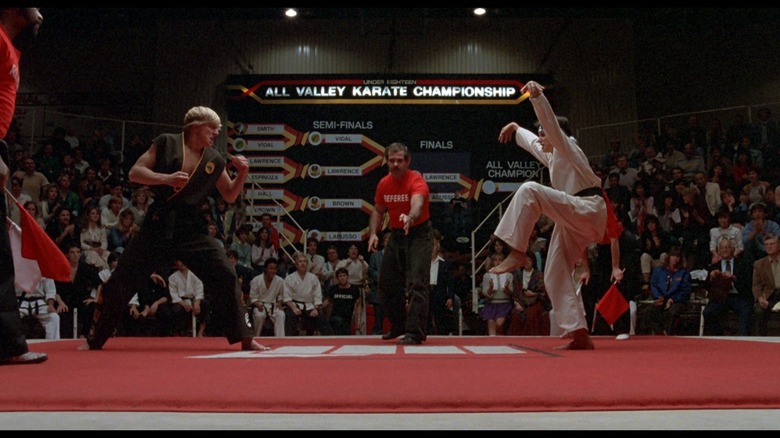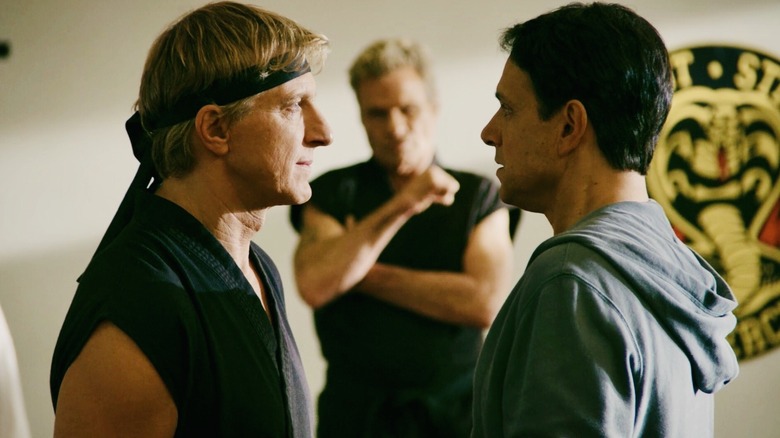Steadiness is not simply one thing that martial arts virtuoso Mr. Miyagi (the late, legendary Noriyuki “Pat” Morita) likes to harp about to his college students within the “Karate Child” franchise; it is also essential to what makes the property tick. Director John G. Avildsen and author Robert Mark Kamen’s unique 1984 “Karate Child” movie established the template for the flicks and reveals that adopted, mixing the gritty realism of Avildsen’s different sports activities traditional, “Rocky,” with energetic martial arts fights and borderline cartoonish antagonists. At their greatest, these tales of troubled, scrappy teenage underdogs learning karate underneath the tutelage of Miyagai and his disciples are rousing coming-of-age sagas able to presenting heavy material in a crowd-pleasing bundle. At their worst, they nonetheless provide invaluable life classes, even once they veer into the realm of self-parody.
On the entire, “Karate Child” fanatics are inclined to agree concerning the franchise’s excessive and low factors. The unique “Karate Child” continues to be typically considered the gold commonplace on the film facet, whereas the 2010 “Karate Child” reboot — a movie that may formally be retconned as being a part of the higher “Miyagi-verse” within the, on the time of writing, upcoming “Karate Kid: Legends” — is generally regarded on as a slicker and fewer efficient however in any other case respectable retread (regardless of it being about kung fu and never, y’know, karate). On the other finish of the spectrum, “The Karate Child Half III” was the tipping level the place the property one way or the other turned too lethal critical and completely ridiculous on the similar time. Then there’s the red-headed stepchild that’s the Hilary Swank-starring 1994 mushy reboot “The Next Karate Kid,” which is better than its unflattering reputation would suggest.
If we use IMDb rankings as our guiding gentle, although, there’s one entry within the Miyagi-verse that crane-kicks larger than all the remaining — specifically, a TV present that options most of the similar tropes as your common anime sequence. However am I referring to the 1989 “Karate Child” cartoon or “Cobra Kai?”
IMDb customers agree: Cobra Kai is the very best round
“Cobra Kai” creators Josh Heald (author of the “Sizzling Tub Time Machine” films), and Jon Hurwitz & Hayden Schlossberg (the scribes behind the “Harold & Kumar” movies) have a aptitude for taking dangerous concepts and dealing wonders with them. Living proof: a “Karate Child” legacy sequel sequence centering on golden locks-adorned “Karate Child” dangerous boy Johnny Lawrence (William Zabka) as a middle-aged washout would not precisely learn like a surefire profitable recipe. And but, from its very first episode (again when it was, amazingly, a YouTube Crimson unique), “Cobra Kai” strikes with such confidence that it is virtually not possible to not get sucked in.
IMDb users agree, as evidenced by the truth that “Cobra Kai” holds a franchise-high common rating of 8.4 on the web site primarily based on some 218,000 votes, with the 1984 “Karate Child” coming in second place with a 7.3 ranking from 254,000 tallies. The factor that basically makes the present tick is its capacity to honor the property’s long-standing theme about karate being indicative of how one lives their life (and vice versa) whereas additionally portray its interpersonal conflicts in deeper shades of gray than the earlier “Karate Child” films ever did. That and its high-flying martial arts motion, which is sort of “John Wick”-like in the best way it depicts folks (often teenagers!) beating the stuffing out of each other by elaborate choreography and dynamic camerawork that really enables you to see what’s occurring.
Like Avildsen’s “Karate Child” trilogy, “Cobra Kai” also gets more ludicrous the further along it goes … which, on this case, is an effective factor. Certainly, within the years because it was acquired by Netflix, the sequence has principally turn into a live-action sports activities anime, with characters obsessing over maxing their “energy ranges” (re: getting higher at karate), teen melodrama up the wazoo, and extra soapy operatics involving folks switching alignments than a “Quick & Livid” sequel. Although all of it, “Cobra Kai” one way or the other finds equal room for each honest drama and self-aware levity, poking enjoyable at itself even because it performs the sound of a hawk caw each time a mohawked teenager nicknamed “Hawk” (Jacob Bertrand) prices into battle with out batting a watch. Perhaps Mr. Miyagi was onto one thing with all that discuss of steadiness in spite of everything.
“Cobra Kai” is streaming on Netflix.
Steadiness is not simply one thing that martial arts virtuoso Mr. Miyagi (the late, legendary Noriyuki “Pat” Morita) likes to harp about to his college students within the “Karate Child” franchise; it is also essential to what makes the property tick. Director John G. Avildsen and author Robert Mark Kamen’s unique 1984 “Karate Child” movie established the template for the flicks and reveals that adopted, mixing the gritty realism of Avildsen’s different sports activities traditional, “Rocky,” with energetic martial arts fights and borderline cartoonish antagonists. At their greatest, these tales of troubled, scrappy teenage underdogs learning karate underneath the tutelage of Miyagai and his disciples are rousing coming-of-age sagas able to presenting heavy material in a crowd-pleasing bundle. At their worst, they nonetheless provide invaluable life classes, even once they veer into the realm of self-parody.
On the entire, “Karate Child” fanatics are inclined to agree concerning the franchise’s excessive and low factors. The unique “Karate Child” continues to be typically considered the gold commonplace on the film facet, whereas the 2010 “Karate Child” reboot — a movie that may formally be retconned as being a part of the higher “Miyagi-verse” within the, on the time of writing, upcoming “Karate Kid: Legends” — is generally regarded on as a slicker and fewer efficient however in any other case respectable retread (regardless of it being about kung fu and never, y’know, karate). On the other finish of the spectrum, “The Karate Child Half III” was the tipping level the place the property one way or the other turned too lethal critical and completely ridiculous on the similar time. Then there’s the red-headed stepchild that’s the Hilary Swank-starring 1994 mushy reboot “The Next Karate Kid,” which is better than its unflattering reputation would suggest.
If we use IMDb rankings as our guiding gentle, although, there’s one entry within the Miyagi-verse that crane-kicks larger than all the remaining — specifically, a TV present that options most of the similar tropes as your common anime sequence. However am I referring to the 1989 “Karate Child” cartoon or “Cobra Kai?”
IMDb customers agree: Cobra Kai is the very best round
“Cobra Kai” creators Josh Heald (author of the “Sizzling Tub Time Machine” films), and Jon Hurwitz & Hayden Schlossberg (the scribes behind the “Harold & Kumar” movies) have a aptitude for taking dangerous concepts and dealing wonders with them. Living proof: a “Karate Child” legacy sequel sequence centering on golden locks-adorned “Karate Child” dangerous boy Johnny Lawrence (William Zabka) as a middle-aged washout would not precisely learn like a surefire profitable recipe. And but, from its very first episode (again when it was, amazingly, a YouTube Crimson unique), “Cobra Kai” strikes with such confidence that it is virtually not possible to not get sucked in.
IMDb users agree, as evidenced by the truth that “Cobra Kai” holds a franchise-high common rating of 8.4 on the web site primarily based on some 218,000 votes, with the 1984 “Karate Child” coming in second place with a 7.3 ranking from 254,000 tallies. The factor that basically makes the present tick is its capacity to honor the property’s long-standing theme about karate being indicative of how one lives their life (and vice versa) whereas additionally portray its interpersonal conflicts in deeper shades of gray than the earlier “Karate Child” films ever did. That and its high-flying martial arts motion, which is sort of “John Wick”-like in the best way it depicts folks (often teenagers!) beating the stuffing out of each other by elaborate choreography and dynamic camerawork that really enables you to see what’s occurring.
Like Avildsen’s “Karate Child” trilogy, “Cobra Kai” also gets more ludicrous the further along it goes … which, on this case, is an effective factor. Certainly, within the years because it was acquired by Netflix, the sequence has principally turn into a live-action sports activities anime, with characters obsessing over maxing their “energy ranges” (re: getting higher at karate), teen melodrama up the wazoo, and extra soapy operatics involving folks switching alignments than a “Quick & Livid” sequel. Although all of it, “Cobra Kai” one way or the other finds equal room for each honest drama and self-aware levity, poking enjoyable at itself even because it performs the sound of a hawk caw each time a mohawked teenager nicknamed “Hawk” (Jacob Bertrand) prices into battle with out batting a watch. Perhaps Mr. Miyagi was onto one thing with all that discuss of steadiness in spite of everything.
“Cobra Kai” is streaming on Netflix.




















